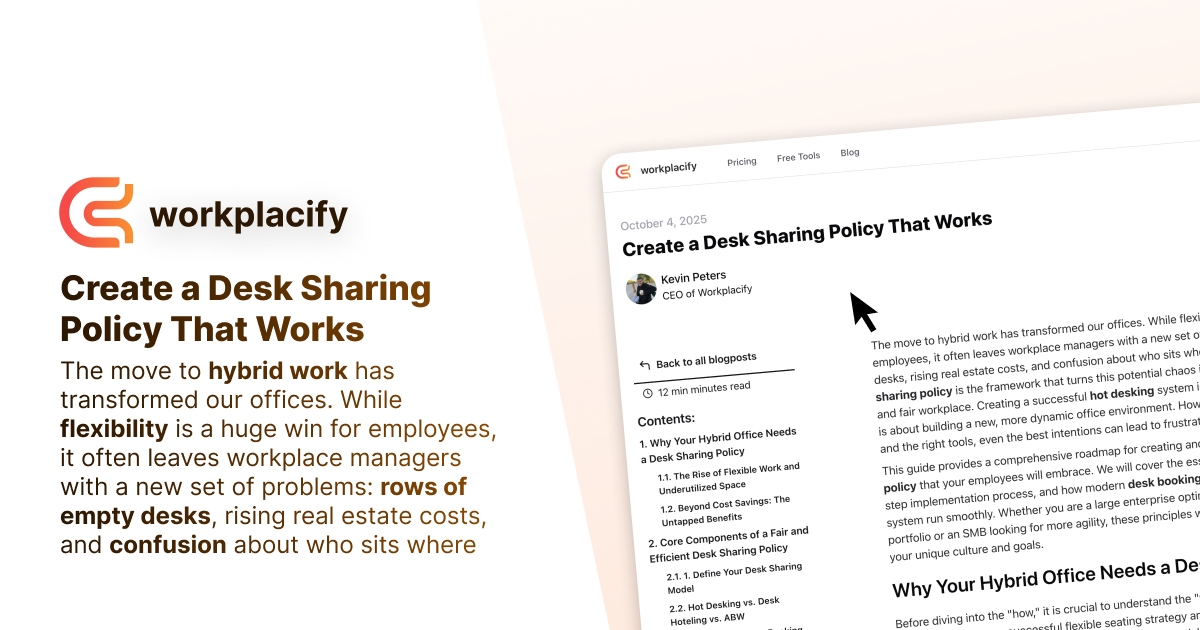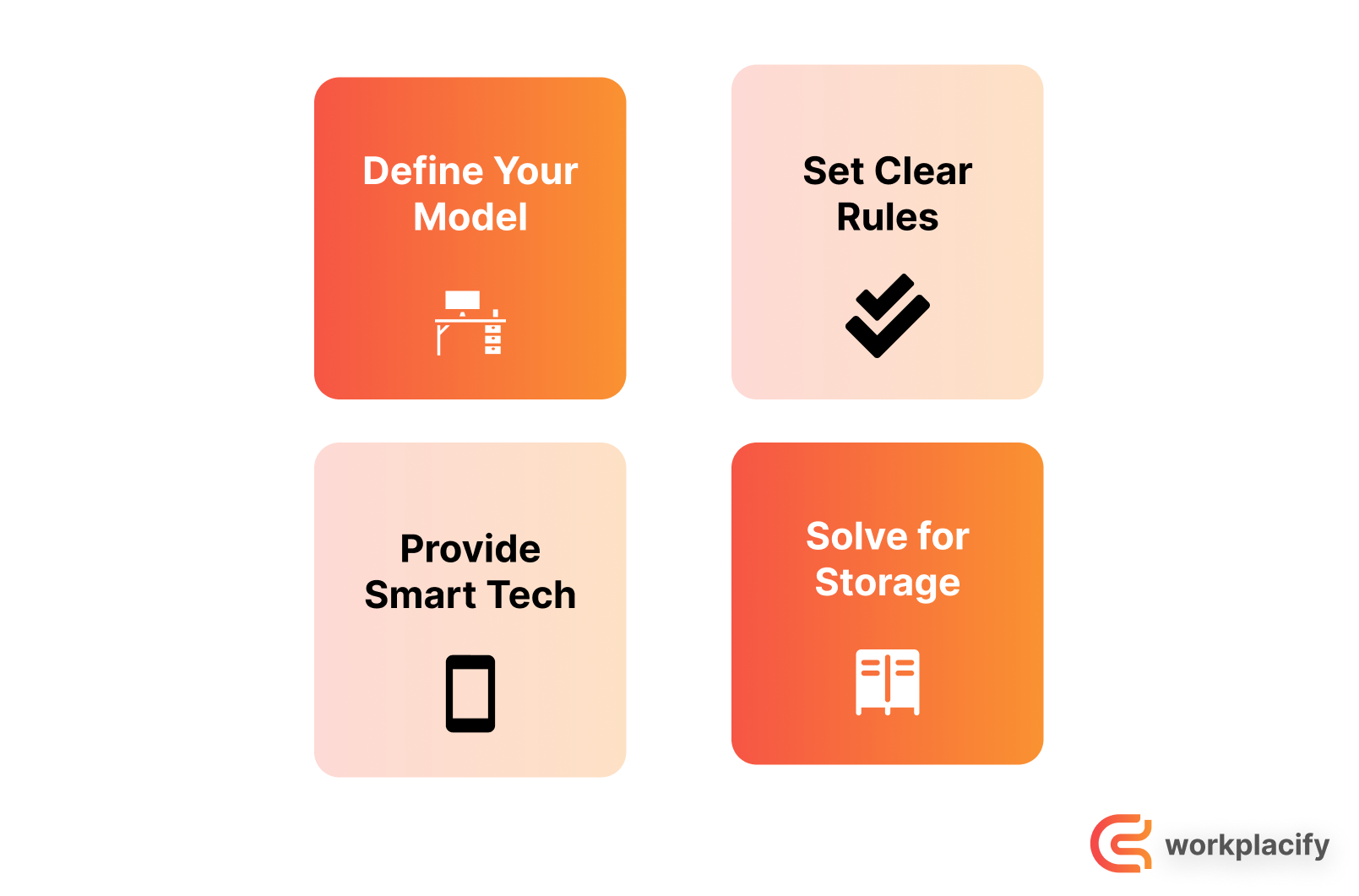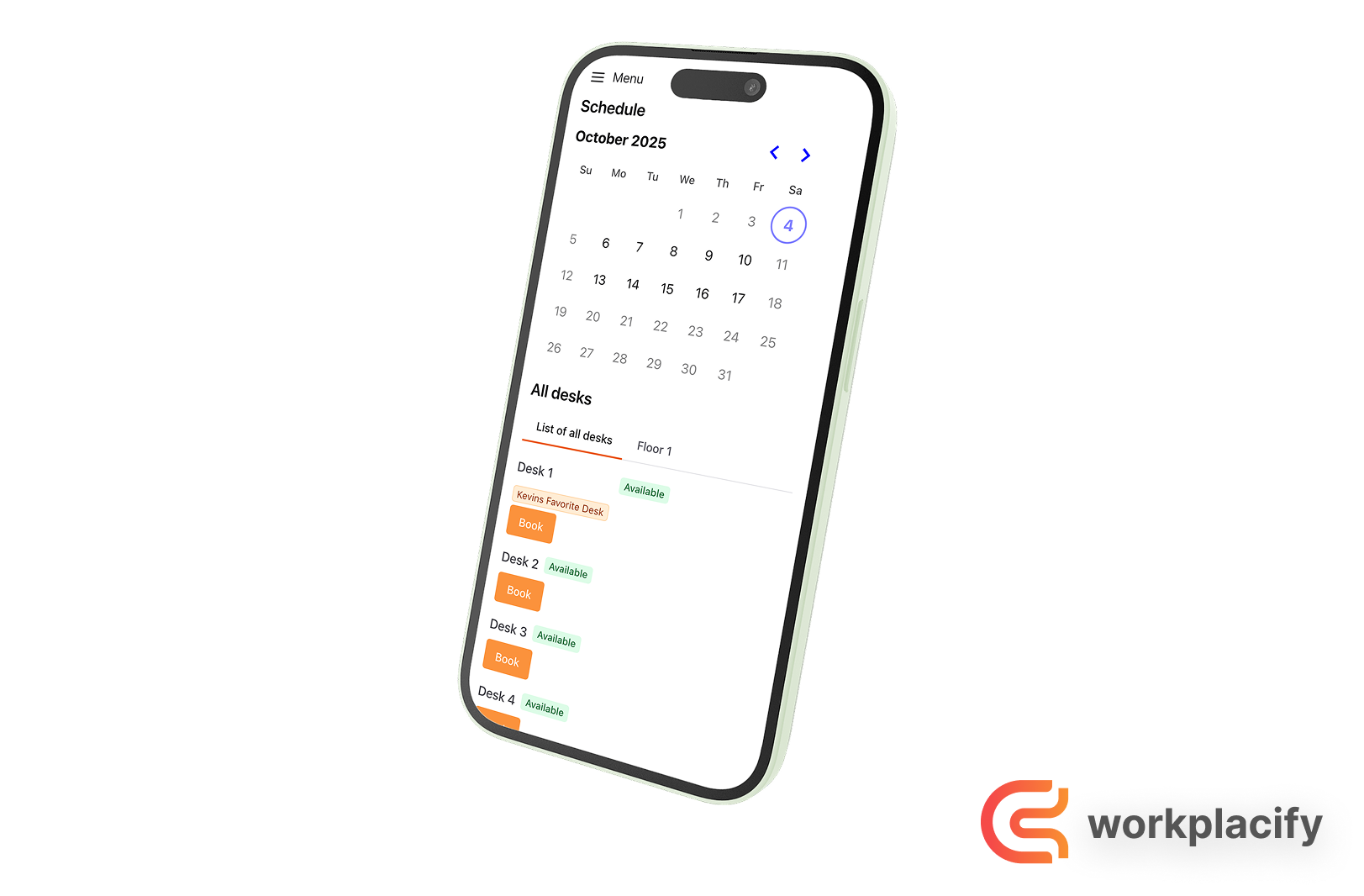workplacify
Create professional hybrid workplace policies
Calculate potential savings from optimizing desk usage
Create professional visitor badges with QR codes
October 4, 2025
Create a Desk Sharing Policy That Works

Kevin Peters
CEO of Workplacify

The move to hybrid work has transformed our offices. While flexibility is a huge win for employees, it often leaves workplace managers with a new set of problems: rows of empty desks, rising real estate costs, and confusion about who sits where. A well-crafted desk sharing policy is the framework that turns this potential chaos into an efficient, collaborative, and fair workplace. Creating a successful hot desking system is not just about cutting costs; it is about building a new, more dynamic office environment. However, without clear guidelines and the right tools, even the best intentions can lead to frustration.
This guide provides a comprehensive roadmap for creating and implementing a desk sharing policy that your employees will embrace. We will cover the essential components, the step-by-step implementation process, and how modern desk booking software can make the entire system run smoothly. Whether you are a large enterprise optimizing a global real estate portfolio or an SMB looking for more agility, these principles will help you build a policy that fits your unique culture and goals.
Why Your Hybrid Office Needs a Desk Sharing Policy
Before diving into the "how," it is crucial to understand the "why." A formal policy is the difference between a successful flexible seating strategy and a daily scramble for space. It provides structure, fairness, and clarity, which are essential for any significant change in the work environment.
The Rise of Flexible Work and Underutilized Space
The data is clear: offices are not being used the way they were before. According to research from JLL, global office attendance has stabilized at 3-4 days per week for the average employee. This means on any given day, a significant portion of your desks are likely sitting empty. A desk sharing policy directly addresses this inefficiency. By moving away from assigned seating, you can reduce your real estate footprint or reconfigure the space for more collaborative zones, meeting rooms, and quiet areas. This is not just about saving money on rent; it is about reinvesting in a workspace that better serves the needs of a hybrid workforce. It allows you to create a more dynamic environment that supports different types of work, from focused individual tasks to spontaneous team huddles.
Beyond Cost Savings: The Untapped Benefits
While real estate optimization is a primary driver, the benefits of a flexible desking policy extend far beyond the balance sheet. CBRE research shows that companies implementing smart workplace policies can reduce real estate costs by up to 30% while improving employee satisfaction. When done right, hot desking encourages cross-departmental interaction. Employees who might never have crossed paths now sit near each other, sparking new conversations and fostering a stronger sense of community. This can lead to increased innovation and a more cohesive company culture. Furthermore, a well-managed policy levels the playing field. It removes the traditional hierarchy associated with corner offices and prime desk locations, creating a more equitable environment. For employees, it provides the autonomy to choose a workspace that suits their task for the day—a quiet corner for focused work or a collaborative hub for a team project. This flexibility and choice are key drivers of employee satisfaction and engagement in a modern workplace. According to Gartner research, organizations that successfully implement flexible work policies see significant improvements in employee engagement and productivity.
Core Components of a Fair and Efficient Desk Sharing Policy
A successful policy is built on a few key pillars. These components provide the structure and clarity needed to ensure the system is easy to understand, fair for everyone, and efficient for the business.
1. Define Your Desk Sharing Model
Not all desk sharing is the same. The first step is to choose a model that aligns with your company culture and work styles.
Hot Desking vs. Desk Hoteling vs. ABW
Hot Desking: This is the most common model, where employees find an available desk on a first-come, first-served basis each day they are in the office. It is simple but can create uncertainty if demand is high.
Desk Hoteling: A more structured approach where employees book or reserve a specific desk in advance using a system, much like booking a hotel room. This is the model Workplacify specializes in, as it provides certainty and valuable utilization data. For more details, see our breakdown of desk sharing vs. hot desking.
Activity-Based Working (ABW): This is a more holistic model where the entire office is designed around different "zones" for specific activities (e.g., quiet zones, collaborative zones, private pods). Employees move between zones throughout the day based on their tasks, rather than having one desk.

2. Establish Clear Booking Rules and Etiquette
Your policy must clearly outline the rules of engagement. This prevents confusion and ensures fairness.
Booking Windows and Limits
Define how far in advance an employee can book a desk (e.g., up to two weeks) and if there are any limits on consecutive bookings for the same desk. This prevents individuals from "squatting" on prime spots and ensures everyone gets fair access. For example, your policy might state: "Desks can be booked up to 10 business days in advance. No single desk may be booked by the same employee for more than 3 consecutive days."
The "Clean Desk" Mandate
A clean desk policy for hot desking is non-negotiable. The rule should be simple: at the end of the day, the desk must be cleared of all personal items and wiped down, ready for the next person. This includes papers, mugs, and personal equipment. Providing cleaning supplies at each workstation encourages compliance. This is a foundational element of desk sharing etiquette guidelines.
3. Solve the Storage and Personalization Puzzle
One of the biggest anxieties employees have about hot desking is, "Where will I put my stuff?" Your policy must address this directly. Provide secure day-use lockers where employees can store personal belongings, laptops, and work materials. Some companies opt for mobile pedestals or caddies that employees can take to their desk for the day. For personalization, encourage digital methods like digital photo frames or customized laptop backgrounds, shifting the focus from physical to digital personalization.
4. Address IT and Equipment Needs
Consistency is key. To make any desk a viable workstation, you need standardized IT setups. This means every bookable desk should have the same equipment: a universal docking station, at least one monitor, a keyboard, and a mouse. This plug-and-play approach minimizes downtime and frustration. Your policy should also clearly outline the process for reporting broken equipment or getting IT support. A ticketing system integrated with your desk booking software can streamline this process significantly.
How to Implement Your Hot Desking Policy Successfully
A policy on paper is useless without a thoughtful implementation plan. Successful adoption hinges on communication, employee buy-in, and having the right tools in place.
Step 1: Gather Employee Feedback First
Do not create your desk sharing policy in a vacuum. The best way to ensure buy-in is to involve employees from the start. Conduct surveys to understand their concerns, work habits, and what they need to be productive in the office. Ask questions like: "How many days a week do you plan to be in the office?" and "What is most important to you in a workspace?" Consider running a pilot program with a single department to gather real-world feedback and identify potential issues before a company-wide rollout. This approach makes employees feel heard and valued, transforming them from passive recipients into active participants in the change.
Step 2: Communicate Early and Often
A robust desk sharing communication plan is critical. Start communicating the "why" behind the change long before you communicate the "how." Explain the benefits for both the company (efficiency, better use of space) and the employees (flexibility, choice, better amenities). Hold town hall meetings or Q&A sessions to address concerns openly. Create a central resource hub—like an intranet page—with the full policy document, video tutorials on how to use the booking software, and a detailed FAQ section. When you launch, provide on-site support for the first few weeks to help people adjust to the new system.
Step 3: Choose the Right Technology
Managing a shared desk environment with spreadsheets is a recipe for disaster. It is time-consuming, prone to errors, and provides no real-time visibility or data. This is where dedicated desk booking software becomes essential. Technology is the engine that powers your policy, making the process of finding and booking a desk simple and intuitive for employees while giving managers the data they need to optimize the workspace. Do not let outdated tools be the weak link in your strategy; the hidden costs of spreadsheet scheduling are too high.
The Role of Desk Booking Software in Your Policy
The right technology transforms your desk sharing policy from a static document into a dynamic, living system. It removes manual work, provides crucial data, and creates a better experience for everyone. Gartner research indicates that organizations using digital workplace tools see 40% faster adoption of new workplace policies compared to those relying on manual processes.
Spreadsheets vs. Dedicated Software: A Clear Winner
For any company with more than a handful of employees, a spreadsheet is simply not up to the task of managing hot desking. It quickly becomes a bottleneck for administrators and a source of frustration for employees.
Spreadsheets
Manual & Slow
An administrator must manually update the sheet, leading to delays and potential double-bookings
No Rule Enforcement
Relies on the honor system, which often fails. There is no way to automatically manage booking limits or check-ins
Zero Data Insights
Provides no easy way to analyze usage patterns, making it impossible to know if you have the right number of desks
Desk Booking Software
Real-Time Availability
Employees see an interactive map and can book a desk in seconds from their phone or laptop
Automated Management
Rules for booking limits, check-ins, and no-shows are automatically enforced, freeing up admin time
Powerful Analytics
Provides data on peak usage days, popular desks, and no-show rates, allowing for data-driven optimization of the office space
Key Features to Look for in a Desk Booking Tool
When evaluating the best desk booking software for SMBs or large enterprises, look for a platform like Workplacify that offers these key features:
Interactive Floor Maps: A visual way for employees to see what is available and choose a desk near their team.
Mobile-First Booking: The ability for employees to book a desk easily from their smartphone.
Integration with Existing Tools: Seamless integration with calendar apps (Google, Outlook) and communication platforms (Slack, Teams).
Utilization Analytics: A dashboard for managers to track key metrics and make informed decisions about the workspace.
Automated Check-in/Check-out: Features like QR code scanning or automatic check-ins to release booked desks if an employee does not show up, maximizing space availability.

Measuring Success and Refining Your Policy
Your desk sharing policy should not be static. It is a living document that should evolve with your company's needs. To do this effectively, you need to track the right metrics. Use the analytics from your desk booking software to monitor key performance indicators (KPIs) like:
Average Desk Utilization Rate: Are your desks being used efficiently? This helps you determine if you have too many or too few desks.
Peak Occupancy Days: Which days of the week are most popular? This can inform decisions about team events or all-hands meetings.
Booking-to-Show-Up Ratio: How many booked desks go unused? A high no-show rate might indicate a need for automated check-in reminders or a clearer policy on cancellations.
In addition to quantitative data, continue to gather qualitative feedback through regular employee surveys. Ask how the policy is working for them and what could be improved. Use this combination of data and feedback to make iterative adjustments to your policy, ensuring it remains fair and efficient over time. CBRE's workplace analytics demonstrate that companies using data-driven workspace optimization see 25% higher employee satisfaction scores.
Quick Takeaways
Start with Why: A desk sharing policy is essential for managing underutilized space in a hybrid work model and offers benefits beyond cost savings, such as increased collaboration.
Build a Solid Foundation: Your policy must define your desk sharing model (e.g., hot desking), establish clear etiquette and booking rules, and solve for storage and IT needs.
Prioritize People: Involve employees early by gathering feedback. A strong communication plan is crucial for successful implementation and change management.
Use the Right Tools: Spreadsheets are inefficient and error-prone. Dedicated desk booking software like Workplacify automates the process, ensures fairness, and provides critical usage data.
Measure and Refine: Continuously track metrics like utilization rates and employee feedback to make data-driven adjustments to your policy over time.
Fairness is Key: Implement features like booking limits and a clear cancellation policy to ensure everyone has equitable access to the space.
Ready to Make Desk Sharing Simple?
See how Workplacify's desk booking software can automate your policy, eliminate spreadsheets, and create a seamless office experience. Try it free today.
Conclusion: Build a Policy for People, Not Just Desks
Creating a fair and efficient desk sharing policy is a strategic imperative for any organization embracing hybrid work. It is about more than just managing physical assets; it is about creating a workplace that is responsive to the needs of its people. A successful policy provides the perfect balance of structure and flexibility, giving employees the autonomy to choose how and where they work best while providing the business with the efficiency and data it needs to thrive.
By following the steps outlined in this guide—defining your model, establishing clear rules, communicating effectively, and leveraging powerful desk booking software—you can move beyond the challenges of empty desks and scheduling headaches. You can build a dynamic, collaborative, and cost-effective workplace that truly works for everyone. The future of the office is flexible, and a well-designed hot desking policy is your map to navigating it successfully.
Frequently Asked Questions (FAQs)
We want to hear from you!
We have outlined the key steps for a successful desk sharing policy. What has been your biggest challenge with hot desking in your company? Share your experience in the comments below!
workplacify
© 2025 workplacify. All rights reserved
Find Us
GitHub